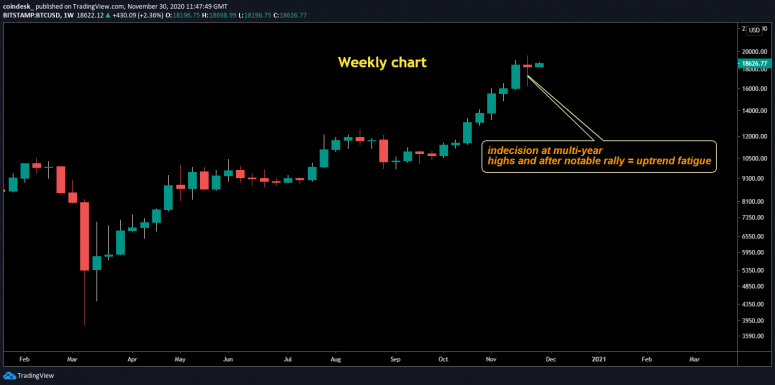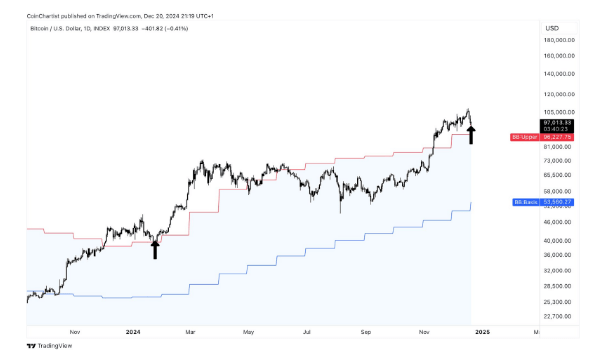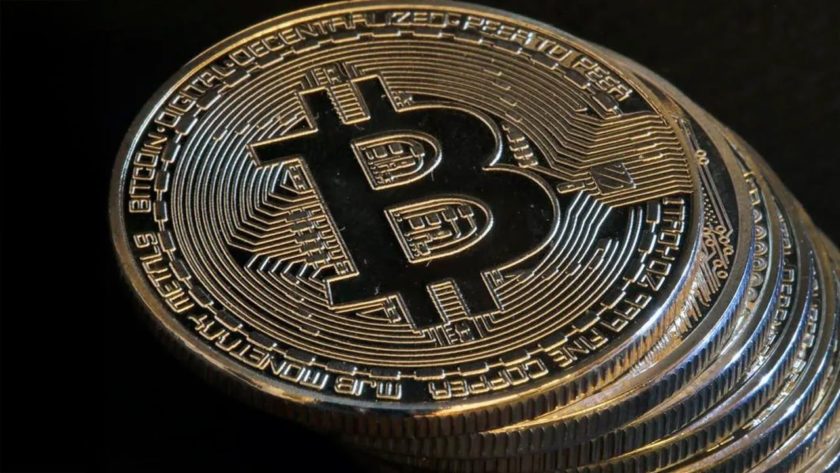Bitcoin was higher, appearing to mount a fresh run toward the all-time high near $20,000. The largest cryptocurrency slid 1.3% in the seven days through Sunday, snapping a seven-week winning streak.
As November draws to a close, bitcoin is up 37% just this month, its best performance since May 2019.
“Even if the market has some froth, bitcoin fundamentals look sound,” the blockchain research firm Chainalysis wrote in a report.
In traditional markets, European shares were steady and U.S. stock futures pointed to a lower open as investors turned cautious after big gains over the past few weeks boosted coronavirus-vaccine developments.
Market moves
From a broad 2020 perspective, it’s hardly news bitcoin in November once again outperformed the world’s major asset classes.
During a month when a closely tracked gauge of global equities, the MSCI World Index, surged 13% for its best performance on record, bitcoin jumped nearly three times as fast.
But that’s been happening a lot recently, with the cryptocurrency up an astounding 163% so far in 2020, or roughly 13 times the 13% year-to-date gains for U.S. stocks. Gold is up 17% in 2020.
Yet, in hindsight, November may prove to be a crucial month for bitcoin for a few key reasons.
First, in a theme that First Mover has repeatedly hammered this year, many large institutional investors are herd followers, driven by backward-looking performance track records, and they often just ape other investors who have previously performed well. The latest announcement of institutional adoption – perhaps the buzziest of buzzwords these days among cryptocurrency analysts – arrived over the weekend from the $233 billion investment firm Guggenheim. November’s outperformance, coupled with a raft of breathless headlines in traditional financial media trumpeting bitcoin approach toward record highs, is likely to entice even more big investors. Even platinum, which is suddenly in vogue because of its potential demand from clean-energy technologies, is up just 14% in November.
Second, bitcoin has brushed off a few market incidents that, in other years, might have sparked a steep sell-off. There were the massive outflows from one of the largest cryptocurrency exchanges, OKEx, after the lifting of a protracted suspension on withdrawals. There was the news that the U.S. Treasury Department might be considering new onerous cryptocurrency regulations during President Donald Trump’s final months in office. There were data showing that big cryptocurrency investors known as “whales” might be moving their bitcoin onto exchanges, preparing to take profits – and potentially swamping the market. Sure, bitcoin flinched last week. But for a market that’s given so much this year, it took back very little.
Third, the key 2020 investment narrative for bitcoin – that the cryptocurrency can serve as a hedge against inflation and trillion-dollar stimulus packages from governments and central banks, similar to gold – doesn’t seem to be going anywhere. President-elect Joe Biden says he’ll nominate former Federal Reserve Chair Janet Yellen to become Treasury Secretary, and as a private-sector commentator she’s advocated for more government stimulus. But with U.S. lawmakers potentially gridlocked, the Fed may have to keep buying government bonds to stimulate markets; U.S. Treasury-bond yields have stayed close to historic lows, on speculation that this is likely the case.
Bitcoin has had a very good year. In hindsight, November may turn out to be its most crucial month.
Bitcoin watch

Bitcoin looks set to post its highest-ever monthly price close.
The cryptocurrency is currently trading around $18,600 on major exchanges. That’s significantly higher from the peak month-end price of around $13,880 observed on Dec. 31, 2017.
The impending record close could be a harbinger of a stronger bull run, according to some observers. “Every time bitcoin has closed above the previous monthly all-time high, a 700% to 1,000% uptrend has followed,” crypto analyst Josh Rager tweeted earlier in the month.
Bitcoin jumped nearly 27% in April 2017, toppling the previous monthly close record of around $1,150 reached in November 2013. What followed was a steep rally to nearly $20,000 by December 2017. Strong rallies were seen after bitcoin set record monthly closing prices in January and October 2013.
The recent seven-week-long rally started around $10,000, and prices climbed as high as $19,400 before last week’s correction. The much-anticipated break above $20,000 may take some time, since signs of uptrend fatigue have now emerged on the weekly chart. The cryptocurrency carved out a large Doji candle last week, indicating indecision or buyer exhaustion after a notable rally. As such, a deeper pullback to levels below Thursday’s low of $16,242 cannot be ruled out.
“The previous froth in momentum traders’ positioning has been cleared to a large extent,” analysts at JPMorgan said in a Nov. 27 note, while adding momentum signals will continue to deteriorate unless bitcoin recovers quickly and momentum traders have room to further propagate the decline.
The No. 1 cryptocurrency by market value fell by over $3,000 to $16,242 on Nov. 26, clearing out excess leverage from the derivatives market. The dip was short-lived and prices have recovered more than 50% of the pullback in the days since.
What’s hot
- Basis Cash launch brings defunct stablecoin into DeFi era (CoinDesk)
- DeFi protcol YearnFinance merges with market coverage provider Cover (CoinDesk)
- Industry pros weigh in on rumors that U.S. Treasury department might be considering new regulations for self-hosted wallets (CoinDesk)
- Ripple is cashing out a third of stake in surging MoneyGram (CoinDesk)
- Timestamps on previously unpublished emails from Satoshi Nakamoto spark fresh debate on Bitcoin inventor’s whereabouts (CoinDesk)
- Facebook-backed Libra targets January for launch of dollar-pegged stablecoin (Financial Times)
- Guggenheim fund proposes in filing to invest up to $500M in bitcoin through Grayscale trust (CoinDesk) (NOTE: Grayscale is a unit of CoinDesk parent Digital Currency Group)
- Bilateral Saudi, UAE digital currency experiment shows benefits of distributed ledgers, central banks say (CoinDesk)
- Curve Finance votes to distribute nearly $3M in accrued fees to holders of CRV governance tokens (CoinDesk)
- Russian bankers tell central-bank official they would gladly serve as intermediaries for a digital ruble, but fear a scenario where the Bank of Russia provides direct individual accounts could spark bank runs (CoinDesk)
- New York Times reveals claims of “racist or discriminatory” treatment of employees at cryptocurrency exchange Coinbase (CoinDesk)
Analogs
The latest on the economy and traditional finance
- The world is bingeing on debt, and smashing records, with $9.7T issued in 2020 by companies and governments (WSJ)
- Black Friday was bust for many stores, better for online (WSJ)
- U.S. Congress confronts deadlines on spending, stimulus and Shelton (Bloomberg)
- China expands programs allowing residents to buy overseas stocks, as yuan gains in global foreign-exchange markets (South China Morning Post)
- Investors pile into risky ETFs during wild market rally (WSJ)
- U.S. economic downturn is hitting state and local government budgets, and 2021 could be worse (WSJ)
- From San Francisco to Washington, public transit agencies are slashing services, staff as coronavirus (and remote working) keeps ridership low (WSJ)
- The CEO of Tokyo’s stock exchange is set to resign after an outage in October saw platform go offline for entire day (Reuters)
- JPMorgan wants to tap growth from Asia’s second-largest wealth market by doubling the number of private bankers serving Chinese clients from Singapore over two years (Bloomberg)
- Measures of Chinese economic activity signal widening recovery (WSJ)





